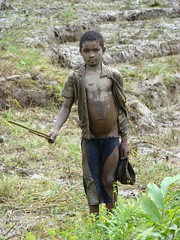 Many people say that giving smallholder farmers a stronger position in market chains is one of the best methods of helping them out of poverty, and that applies particularly to the neglected, orphaned, underused etc crops that are our bread and butter. Is it true? A new study in World Development says it is. ((The study, by Marc Bellemare, is of poor farmers in Madagascar, so I’m guessing they farm rice, like the boy in the photo, found on Jaaskier1’s Flickr stream.)) The article is behind a paywall, and even if it weren’t I am pretty confident that I wouldn’t understand the details. So how do I know that “participation in agricultural value chains make[s] smallholders better off”?
Many people say that giving smallholder farmers a stronger position in market chains is one of the best methods of helping them out of poverty, and that applies particularly to the neglected, orphaned, underused etc crops that are our bread and butter. Is it true? A new study in World Development says it is. ((The study, by Marc Bellemare, is of poor farmers in Madagascar, so I’m guessing they farm rice, like the boy in the photo, found on Jaaskier1’s Flickr stream.)) The article is behind a paywall, and even if it weren’t I am pretty confident that I wouldn’t understand the details. So how do I know that “participation in agricultural value chains make[s] smallholders better off”?
Because the author says so.
Which of course he would, although in this case he does so with a blog post explaining just why his study is so much more conclusive than anything that has gone before. And that I could understand. Not the details of how he got there, which is still a long way outside my expertise. But where he got to, which was here:
At the end of the day, I find that contract farming significantly increases the income of participants. Perhaps more importantly, I find that contract farming increases the income net of contract farming revenue of participants. In other words, there are positive spillovers on other sources of income (here, income from from sales of livestock and income from other agricultural sources such as the sales of non-contracted crops and animal byproducts).
More broadly, I’m seeing, and liking, more of these blog posts from scientists about their science. And while not all scientists are capable, not by a long shot, those who can are, I am sure, adding to their reach and impact. Just sayin’